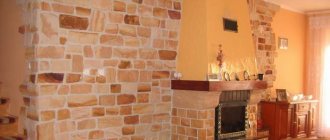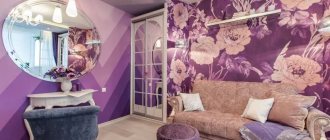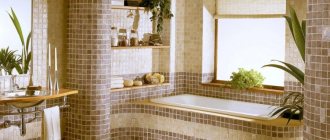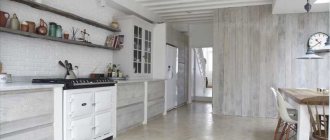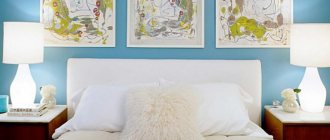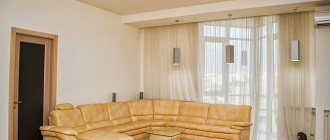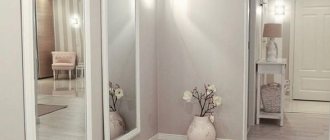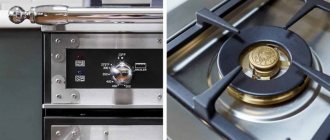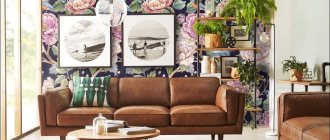0
30.10.2021
Today, there are many options for covering the walls in the kitchen other than wallpaper. There is a choice of the traditional option - painting the walls, laying tiles and wallpapering. There are also more practical methods, for which you will have to pay a large sum of money. Options for finishing materials for the kitchen should be chosen according to many criteria, the main ones being dirt washability, heat resistance and moisture resistance.
Apart from wallpaper, kitchen walls can be decorated with a variety of other materials.
Requirements and finishing features
Page navigation
When decorating kitchen walls in your home, you should give preference to materials that are resistant to soaking. The main requirement for cladding in the kitchen is water resistance, since even with the slightest absorption of moisture, the walls will begin to deteriorate.
As a rule, paper wallpaper, fabric and PVC panels begin to lose their shape and come off first. Therefore, we can conclude that the cheapest materials are absolutely not suitable for the kitchen.
The second main requirement for decorating walls in the kitchen is to choose a material with a washable surface. This is especially true for the area next to the work surface near the stove. When cooking, fat and other liquid products can splash around, damaging not only the walls, but also the floor and ceilings.
It is worth considering the fire resistance of materials, as well as the lack of ability to release toxic substances in high temperature conditions.
Methods for laying tiles
The most popular ways of arranging tiles on the surface of walls are in horizontal stripes, in which vertically adjacent elements can be strictly above each other or alternate (checkerboard pattern). But if you wish, you can choose a more interesting option.
Diagonal masonry
This method has an undoubted advantage - it helps to visually expand the boundaries of the kitchen. However, not every tile will do, only square ones. With a rectangular one it is more difficult to achieve strict lines, so it is not used for laying out in a diagonal direction. The use of several colors greatly enlivens the picture, but you can get by with just one, highlighting the directions with a contrasting shade of grout.
Only the apron can be decorated with a diagonal layout
Mosaic masonry
Usually the term is used in relation to panels laid out from tiles of the smallest size. Many variations on this theme have been invented. Today on sale there are multi-colored mosaics in the form of squares that can be used to lay out any surface (including curved ones). A more expensive option is an individual panel, which will be assembled by a master on the wall. Considering the high cost of the material and its installation, most often only the apron area is decorated with mosaics, but if desired, you can fill all the free parts of the walls with it.
Artistic mosaic panel in the kitchen
General principles for designing kitchen walls
When planning the decoration of walls inside a living space, it is important to maintain a balance between the quality of the coating and the decorative solution.
The kitchen is a room in which a huge amount of time is spent, so it is worth making not superficial, but high-quality repairs from durable materials.
The covering of walls near the work area must be resistant to moisture
Basic principles and rules for decorating walls in the kitchen:
- The cladding must fully respond to changes in humidity in the room. It is best to finish the walls in the kitchen with moisture-resistant materials. Not everything that is of high quality is expensive; you can also find budget options that are easy to clean, for example, tiles, washable types of wallpaper or PVC panels.
- It is worth giving preference to materials that are resistant to high temperatures. If you hang inexpensive paper wallpaper in the stove area, you will soon encounter the problem of damage to the wall covering. Some types of materials begin to change their appearance, acquiring an uneven structure and changing color.
- The wall covering in the kitchen should not deteriorate from the influence of chemicals. The work area is especially susceptible to the adhesion of dirt, grease, etc. It will have to be washed from the surface periodically; the paper or fabric lining will quickly become unusable.
- Odors in the kitchen are often absorbed into the walls, so you should not decorate the room with natural wood.
- It is recommended to choose at least two options for finishing materials. One to decorate the kitchen work area, and the other to cover the dining area.
- For small kitchens in Khrushchev-era buildings, it is not recommended to choose finishing materials with many dark geometric patterns. It is better to give preference to plain light-colored coatings to refresh and visually enlarge the room.
It is important to plan the decorative decoration of the room in advance and take into account all its nuances. Subsequently, any mistake can cost a considerable amount of money, effort and time.
How to choose a tile
Color and design
What color and design of tiles for the kitchen wall to choose is up to you, but it is not recommended to choose too light colors of tiles and grout, including white. The fact is that with this combination, the seams will have to be cleaned much more often and more diligently.
You shouldn’t choose colors that are too dark either, since all the stains, dust, stains and fingerprints will be immediately visible on them. Such tiles will have to be maintained constantly.
Kitchen wall tiles should match or match the tone and design of the rest of the room. If the kitchen interior is made in neutral colors, then a bright apron will be an excellent choice.
For modern kitchens, tiles stylized as stone, metal or wood are suitable. Don’t be afraid to experiment and choose non-standard shapes, for example, rectangular, measuring 10x30 cm.
Practicality and reliability
The tiles are easy to maintain, but some options can cause trouble. If you choose relief tiles, then be prepared that it will not always be possible to wash them completely. Small-format tiles look stylish, but in fact they require more time to clean, as they have so many seams.
To prevent the tiles from deteriorating from various types of liquids, including detergents, choose one that is marked with moisture absorption grade AA or at least A.
When choosing between semi-matte and glossy tiles, you should give preference to semi-matte, as it better withstands impacts, scratches and cleaning with abrasives.
5 nuances when choosing and purchasing
- Only take tiles from one batch, as each batch may vary in tone. At first glance it may seem that there is no difference, but it seems so only before installation, where over time the difference will become an eyesore;
- Always take a little more. No one is immune from defects, chips and unsuccessful pruning. And in the future you will have a reserve if you have to replace part of the tiles;
- To reduce the hassle of cutting and adjusting, take tiles the size of which is a multiple of the size of the backsplash. A universal solution would be “subway” tiles made in the form of bricks. It is easier to install and often requires trimming only at the walls;
- Can't find the right tile for your kitchen work wall? - pay attention to the floor tiles. It is highly durable and is perfect for tiling a backsplash, but wall tiles for the floor will no longer work.
- To save money and find an interesting solution, combine tiles. You can choose a cheaper one, and for inserts after 2-3 tiles, take a patterned or embossed one.
Choice of grout
The grout must have three most important properties:
- Don't let water through
- Repel dirt
- Be resistant to fungus formation
To extend the life of the grout, it is recommended to treat it with a special impregnation. Don't forget about the color: it should be combined with everything else.
Choosing wall color for the kitchen
Designers advise not to clutter the walls in the kitchen with elaborate designs, complex geometric patterns and a variety of bright and too dark colors.
If you want cheerful colors, then you should combine the shade with a pastel background. The same goes for dark shades. If you want black walls in the kitchen, then individual interior items and the work area should be decorated in warmer colors.
Dark kitchen walls are best combined with light furniture
Tips for choosing the right color for kitchen walls:
- Dark shades of wall coverings visually reduce the space, so they are not suitable for small kitchens.
- Light colors, on the contrary, help to enlarge the room, expanding it visually. That is why it is recommended to choose bedding monochromatic colors of finishing materials for miniature rooms.
- Cold colors such as blue, silver, cyan or violet should not be used when covering kitchen walls. Otherwise, it will adversely affect the overall comfort of the room, making the room empty and cold.
- Dark colors can be used on walls that face south, southwest or southeast. The same goes for light colors, which are suitable for walls that are constantly in the shade.
- If the kitchen set and furniture have long, monochromatic shades, then you can paint the walls in bright colors: green, orange, red and others.
Designers do not recommend finishing the walls with material of the same shade as the set and the rest of the furniture in the room.
Kitchen renovation: interior decoration
Ceiling decoration, color, choice of flooring, furniture and accessories depend on the style you decide to create in your kitchen. Think about how this or that fashionable design trend will look in relation to your kitchen.
If the kitchen faces south, decorate with cool colors. On the north side, use rich warm colors.
Things to consider:
- Dimensions and geometry of the room.
- Tastes and character of family members.
- Financial opportunities.
Think:
- What color scheme are you interested in?
- Will you regularly dust small pots, vases and plates?
- How often do guests come to you?
The answers to these questions will help you understand which kitchen design to choose. Pay attention to popular styles:
Country. Warm, homey, lots of accessories, flowers, nice textiles. Wooden furniture, tiles in warm colors, often with patterns. The kitchen requires constant maintenance. Find out what wallpaper to choose for a country-style kitchen here.
Country style with kitchen interior: the charm of natural materials
High tech. For confident, stylish and creative people. Clear lines, modern materials, a minimum of details, a predominance of metallic colors, gray, black, white and red. If you are planning a loft-style renovation, you should read this article.
Provence. Reminds me of country music. The same soft, cozy room. The predominance of greenish-gray tones. Lavender shades are acceptable. Aged furniture, beautiful textiles, original lamps, large windows. For romantics.
Classic, palace style. Ideal design for a spacious kitchen. Expensive furniture, natural materials, stucco, gilding, silver. Elegant wall decor, luxurious textiles. High quality flooring.
Scandinavian style. Abundance of white, spaciousness, gentle, pastel colors. The wooden floor is varnished. Light wood-look furniture is decorated with original handles and carvings. There are candlesticks, cotton curtains with lace and ruffle trim are acceptable. There are stylish accessories in brighter colors. A table in a Scandinavian style looks especially elegant.
When choosing a style and finishing materials, keep in mind that the kitchen is a room with high humidity, with the presence of steam and splashes during cooking.
The kitchen should not only be beautiful, but also functional. Organize the space so that you are not afraid of ruining furniture or expensive wallpaper.
Do you like to have friendly gatherings in the kitchen?
You need a kitchen sofa! Find out how to choose an electric stove here.Read about the pros and cons of warm electric floors at
Ceramic tiles: a practical choice
Ceramic tiles for kitchen interiors are the most popular and time-tested way to decorate walls.
It is a durable material with a long service life, which helps you avoid troubles when cooking. The tiles wash well, do not burn, and most importantly, are inexpensive.
Ceramic tiles are still among the leaders when choosing
Using it, you can make the work area white, which cannot be achieved with wallpaper or paint due to the constant exposure to high temperature and the adhesion of fat to the coating.
Another big advantage of this coating is the huge variety of shapes and colors. There are tiles with patterns, geometric shapes, made to look like wood or stone.
There is no need to tile all the walls in the room; it is enough to highlight the work area. You should choose glossy and smooth tiles that are easy to use.
To make the interior style of the kitchen modern and beautiful, you should select finishing materials based on the color palette of the set and the rest of the furniture.
Decorative plaster - if you want to imitate stone or brick
- reliable imitation of natural material;
- possibility of additional coloring;
- not recommended in work areas.
Let's finish our review with decorative plaster. The material is extremely popular in many construction stores due to its low cost - the attractiveness very well correlates with the fairly high quality of imitation stone and brick textures. Importing natural materials into a modern kitchen interior is an obvious trend in recent years, but it also requires no less obvious material investments. In this regard, the use of gypsum is an extremely successful compromise, from which you get an up-to-date design for your walls with the minimum possible investment.
However, it is not recommended to use gypsum in the work area - it does not have sufficient moisture resistance for this. But in the format of a dining area - a great solution! If you want to extend its service life or get an additional volumetric effect
, then treat the masonry
with varnish
and arrange the correct lighting. You will be surprised how your entire room will be transformed. This is akin to the 3D effect after the usual two-dimensional pictures.
Wall porcelain tiles - all advantages
Porcelain tiles are as durable as tiles. This is an artificial finishing material that successfully imitates stone. Currently, porcelain stoneware has gradually displaced tiles from the pedestal of the best finishing material for the kitchen.
Porcelain tiles fit perfectly into the kitchen interior
The material has managed to prove itself only on its positive sides:
- has a beautiful appearance;
- practical, will last a long period of time;
- washes off dirt well;
- does not absorb moisture, therefore it is also widely used in bathtub design;
- frost-resistant, withstands low temperatures, does not crack;
- resistant to damage and abrasion of patterns;
- will not break upon impact.
For the kitchen, it is best to choose solid colors of porcelain stoneware with a glossy surface to make it easier to clean.
Porcelain tiles in the kitchen can be used to decorate the countertop.
Basic rules for caring for tiles
Compared to any other material, tile is the least demanding to maintain. It can be cleaned from almost any contaminant. But it is easier to do this if the contamination is fresh. Therefore, you should not wait long; cleaning and washing the tiles should be done in the kitchen at least once a week. To clean the seams, it is convenient to use a steam cleaner, which allows you to achieve hygienic cleanliness.
Tiles in the kitchen are beautiful, practical and always original. Installation is expensive, but the result is worth the cost, since even the most affordable tile will last for several decades without losing its freshness.
MDF panels for quick and budget repairs
MDF panels are often used as an affordable, inexpensive finishing material. This cladding looks beautiful, but due to its low quality it will not last as long as tiles or porcelain stoneware.
The big advantage of PVC panels is not only their low cost, but also the huge variety of assortment. You can choose the material to match stone, wood or brick.
MDF panels are quite easy to clean from grease and other dirt; moreover, the material does not deteriorate when in contact with chemical detergents. However, at high temperatures, the slabs can begin to deform, so you need to avoid such problems in the kitchen. It is easy to paste over the panels; the work is done quickly without the need for special skills and abilities.
Decorative painting is an inexpensive, creative way to decorate kitchen walls.
Design options
The design of kitchen walls allows you to make the room not only cozy and comfortable, but also attractive, bright, lively, and cheerful. Various design methods help to zone a room, highlight its advantageous aspects and hide possible shortcomings.
Exotic ornaments, floral patterns, images of fruits, vegetables, dishes create the right mood
They, according to psychologists, have a positive effect on a person’s appetite. You can achieve your goal by combining wallpaper and plastic panels, painting and natural stone, tiles and photo wallpaper.
Decorating kitchen walls can be called a complex process, requiring increased care and accuracy.
Despite the fact that the design of some types of finishing materials does not require preliminary leveling of the walls, care must be taken to ensure high-quality preparation of the surfaces. Moisture-proof panels, tiles and vinyl wallpaper will provide reliable protection against fungus and mold. By combining them with lining or stone, you can create a unique design. When working on the design of a kitchen, they select not only colors and shades, but also decorative materials of similar quality.
Painting: decorative, classic
Wall decoration in the kitchen, options for finishing materials and properly carried out work are the most important topics during the renovation of a room. Painting surfaces is a great option for decorating a kitchen. The main thing here is to choose a quality product and choose a paint color.
The cheapness of paint materials allows you to paint walls in several layers to achieve high-quality, smooth walls. However, you can use a more complex method that requires a little more financial resources. There are expensive paint materials that are enough to paint the wall in one layer immediately after plastering.
To decorate walls, you can purchase decorative paint, which, after drying, acquires fancy patterns, roughness and unevenness.
Unique relief of decorative plaster
- easy application to wall surfaces;
- interesting texture specificity;
- wide range of options;
- quite high cost.
It was not yesterday, or even the day before yesterday, that decorative plaster was used as an option for finishing walls in a kitchen: in fact, it is already a well-tested material, distinguished by its non-trivial visual specificity. It would be very reckless not to use his trump cards to decorate the kitchen. However, in order to get a truly pleasing result, you will have to show some diligence and ingenuity. As a rule, people who have impeccable taste like to work with plaster. In their hands, like plasticine in the hands of a child, it takes on the desired shapes and motifs. Depending on the type of base material used to mix the solution, the following types of decorative plaster are distinguished:
- silicate;
- limestone;
- polymer;
- with the addition of marble chips;
- water based.
Applying plaster to the wall is followed by a process that is much more technically complex - creating the desired relief. True, its complexity is compensated by a healthy bias towards creativity. By simply manipulating the wall in the kitchen, you can achieve such an inventive and expressive finish that you can only dream of if you use other, less plastic materials. Interesting relief types of decorative plaster such as:
- Venetian;
- graffito;
- bark beetle;
- flock, etc.
Of course, in order for the result not to cause disappointment, the working wall needs to be prepared:
- completely get rid of old material;
- analyze for the presence of irregularities and cracks;
- carefully treat them with primer.
As a rule, such finishing material gives the kitchen a more interesting modern look. The walls acquire the necessary solidity, and with favorable lighting spots, you can create a unique warm homely atmosphere
. What else do you need for comfortable eating and relaxation? However, over time, decorative plaster inevitably loses its original “marketable” appearance, so to extend its service life it is recommended to finish it with varnish. You can use glossy - in this case the walls will look beautiful in the evening and at night. Or you can be satisfied with the usual matte finish - you’ll get a more modest, but still quite beautiful and solid effect.
Some photos of the walls in the kitchen with a finishing option such as plaster are below.
Architectural concrete, concrete panels
Concrete is a reliable and time-tested material for laying foundations, pouring paths and finishing walls. If you don’t want to cover the walls with various tiles and panels, you should make a beautiful finish with decorative concrete.
This material is characterized by good strength and is perfect for rooms with a minimalist interior.
Architectural concrete is also used in the creation of kitchen furniture, especially worktops and dining tabletops.
Architectural concrete can be used to decorate a kitchen countertop
Venetian plaster
Venetian plaster is most often used to decorate the so-called kitchen apron and other areas near the work area. This finishing material is suitable for interiors in the style of classicism, Provence or eclecticism.
Mineral particles in the plaster after drying make the walls rough and iridescent in different shades.
The material can be chosen for malachite, marble, granite, quartz and other stones. There is also a choice of the coating itself; it can be glossy, metallic or matte.
Kitchen wall decoration
When choosing a material for wall decoration, keep in mind that there is no escape from grease, splashes of water, dirt and the use of detergents.
The finishing of the work area and walls away from the sink and stove has its own characteristics.
Work area in the kitchen in an apartment, private house
All factors affecting the condition of the wall coating are concentrated here. Install an apron made of materials that are easy to care for near the sink and hob. It is convenient to use washable wallpaper and install a wall panel.
Popular materials for finishing the work area:
- Tile. Choose a smooth, glossy texture if it does not contradict the style. For example, in Provence or country, gloss is inappropriate.
- Ceramic mosaic. It is easy to lay out a suitable pattern from small tiles. The mosaic apron is easy to clean. Looks good in Provence or country style.
- Glass. The material has many variations: mirrored, tinted, with an optical effect, with engraving, etc.
- Varnished wood. New technologies make it possible to treat the material with special compounds that protect the wood well from harmful influences.
- Stainless steel sheet. The ideal kitchen apron for high-tech style. It is easy to care for. The coating looks stylish and impressive. It is forbidden to wash steel with a wire brush.
Flexible stone - environmental friendliness and wide possibilities
Flexible stone comes in the form of wallpaper or tiles and is not plastic or rubber. This is a very thin section of natural sandstone, which was applied to glass canvas.
Flexible stone has many advantages, the main one being environmental friendliness. Other advantages of the material:
- easy installation work;
- fire safety;
- has moisture-repellent properties;
- light weight, so the material is securely attached to a vertical surface;
- It does not require special care;
- The flexibility of the material will allow it to take the desired shape.
Perhaps the only drawback of flexible stone is its high cost, from 1,500 rubles per 1 square meter of material.
Lining can be used to decorate the kitchen and dining area
Wallpaper
Wallpaper in the kitchen is the most affordable and popular material for walls:
- Almost anyone can wallpaper their kitchen on their own.
- With this decoration, the room looks elegant and cozy.
- You can change such clothes for walls quite often, since they do not require large financial, time and labor costs.
Types of wallpaper for the kitchen
But not all types of wallpaper are suitable for decorating a kitchen. It is better to choose fabrics that are moisture resistant and allow you to wash their surface. Vinyl, non-woven and glass wallpaper will cope with this task perfectly.
- Vinyl wallpaper is coated with PVC film, which provides good protection against moisture, grease, soot, dust and other adverse factors present in the kitchen. They can be cleaned with a sponge and detergent without fear of the wallpaper getting wet and peeling off.
- Non-woven wallpaper is famous for its lightness and durability. In addition to these advantages, they are able to mask minor wall defects. Non-woven wallpaper coverings do not absorb water at all; they can also be washed.
- Fiberglass wallpaper is the most durable of the listed varieties. They are absolutely moisture and fire resistant. Fiberglass wallpaper can be coated with paint, and it can withstand several repaintings.
USEFUL INFORMATION: Suspended plasterboard ceilings in a small and narrow room
Lining - the comfort of natural wood
Another idea for covering kitchen walls is to use clapboards. These are thin wall boards that are used to decorate the walls of village or private city houses.
Today, this idea is quite suitable for apartments. The material looks noble and expensive indoors, and ceilings can also be covered with clapboard.
When undertaking work to radically change the home, questions about how to properly renovate the kitchen and how to decorate the walls and ceiling in the kitchen are especially acute. Lining can solve the problem, since it can cover all surfaces of the room, except the floors. This will maintain the uniformity of the entire room, save money and time, and also help make the interior more harmonious and cozy.
Interesting ideas in interior design
In addition to the above ways to decorate the walls in the kitchen, there are several more unusual ideas:
- Plastic panels or PVC, which can be used to decorate the kitchen work area. They are easy to clean and pleasant to the touch. You can choose different colors and patterns, and also cover one entire wall with such panels.
- Aluminum sheets are a rather unusual idea to decorate walls instead of wallpaper. This finishing material comes in corrugated and smooth shapes, suitable for any kitchen interior design.
- Parquet can be used not only for floors, but also for walls. The material is not heavy and will stand firmly if you use it on the walls. Parquet can replace not only boring wallpaper, but also tiles or panels.
You should not pile up the entire room with plastic and aluminum panels. It is enough to paste the work area or decorate one of the walls with finishing material.
Wallpaper has become an unreliable way to decorate kitchen walls.
Which method of wall decoration, other than wallpaper, to choose for the kitchen, everyone must determine for themselves according to certain criteria. It is worth considering not only the quality and price category of the product, but also its decorative features. With a light hand, a kitchen renovation can become the first round of a new life.
How to decorate the walls in the kitchen
An urgent task for many consumers today is the question of how to decorate the walls in the kitchen. The most common combination is ceramic tiles plus wallpaper. But you can paint the walls or cover them with decorative plaster. Some areas can be lined with decorative or natural stone.
If you want to decorate a room in a certain style, you can even use lining, but it should first be treated with fire retardants and antiseptic compounds. But PVC panels can imitate various natural materials. The apron can be decorated with glass panels. The interior of the room is often complemented by metal elements.
Wallpaper is washable and paintable
The walls of a small kitchen are often decorated with washable wallpaper. This not only simplifies the repair, but also makes it budget-friendly. You can choose this material taking into account the base and outer covering. The canvases can be made on a paper basis or be non-woven. The latter are able to hide minor surface imperfections. They are easy to stick and allow you to decorate walls by applying adhesive to the surface. During installation work, the canvases are not deformed, which is very convenient. The outer layer of washable wallpaper can be:
- acrylic;
- vinyl;
- non-woven;
- metallized.
Using acrylic canvases, you can even use them to decorate a work wall in the kitchen. This material is breathable, durable and fairly inexpensive. Vinyl wallpapers are made on a paper or non-woven basis, which are also very durable, are not afraid of moisture and can withstand mechanical damage. The external pattern will not be erased over time, and the canvases themselves are highly dense. The same finish can also be painted. The texture will remain unchanged, but the shade can be changed from time to time.
Vinyl can be not only a base, but also a decorative layer. Such coatings can be painted up to 15 times. The material is universal, so it can be used in any room, and humidity and temperature changes are not a hindrance.
The interior walls will not only look good, but will also allow the housewife to wash them thoroughly if they are covered with glass wallpaper. This coating can be recognized by its characteristic pattern, for example, in the form of a herringbone. The material can be single-layer or two-layer, and repainting is permissible up to 10 times. The texture will be preserved in its original form. The wall can be washed after such cladding; the material is completely safe for health, because it is based only on natural ingredients.
The main advantage is the ability to care for the coating even with a rough brush and chemicals.
Finishing work in a small kitchen can be done using metallized wallpaper with a porous or fabric base. The surface is coated with aluminum foil, embossed or painted. Such decoration of kitchen walls will be quite expensive, it will last a long time, looks attractive, and can be combined with kitchen fittings and sanitary faucets.
Architectural concrete, concrete panels
If you want to make the decorative decoration of your walls not only durable, but also unusual, you should resort to the method of installing panels under concrete. They are also called architectural concrete and are offered in different textures, sizes and colors. With the help of such products you can decorate a room in a loft style. A kitchen design with such finishing will look truly unique.
Today, decorative panels are very fashionable; they are designed in accordance with modern trends and can fit into the interior of almost any room. This finish is not an imitation of concrete, it is real concrete, characterized by lightness and high rigidity. The base can be flexible or rigid. It is based on a composite material based on synthetic resins and micro-concrete. The surface can be subjected to stress and wet cleaning. The products combine well with other materials, and during installation they can be installed on a frame, which will allow you to hide communications under it and save on finishing.
Decorative plaster
Decorative wall decoration in the kitchen may involve the use of plaster. It is offered in different textured and composite solutions. When applied, you can create different effects, for example:
- rock;
- stone;
- marble chips;
- rain;
- bark beetle;
- fur coat
If there is no experience, the interior decoration of kitchen walls with plaster can be done by forming a rock on the wall. And the composition should be based on cement and gypsum. You can purchase the mixture ready-made by stirring it by hand. To improve the quality of the finishing coating, the wall should be prepared with a layer of putty and primer. A structural pattern begins to be created after the solution is distributed over the area. To do this, you can attach the smoother to the base and start the motor with it downwards, slightly lifting the lower edge. This will result in an unusual, uneven texture that clearly resembles stone.
Ceramic tile
Ceramic tiles look great in the kitchen space. It is more durable than wallpaper and plaster, and it can be used not only on walls, but also when forming an apron. It is not worth purchasing this material with precision down to the element, since there are always errors when laying, in addition, you will need products for trimming. Among the most significant advantages of this cladding, we should also highlight a wide selection of colors, as well as a range of prices.
The walls will simply be easy to care for. But sometimes you need to entrust the choice to specialists so that the kitchen interior looks harmonious. Tiles are often combined with vinyl wallpaper. This material is fireproof and moisture resistant. Taking into account the first factor, it can even be used on the wall behind the stove.
When choosing tiles, you need to pay attention to the markings. If you notice the following designation: PEI-I, it indicates that the ceramics are suitable for simple operating conditions, but tiles with average resistance to stress are designated as PEI-III. Perhaps it is suitable for household use. When considering the types of finishing materials, you will probably also think about the design of the floor. It is suitable for tiles marked PEI-V, which indicates the highest degree of wear resistance.
MDF panels
Kitchen walls can be decorated with MDF panels if this material is not installed on all walls. It is based on wood, which can be a fire hazard. Without treatment, the surface of MDF walls can delaminate and change geometric parameters at the level of individual elements. But if you line the interior walls of the kitchen with panels, successfully combining them with the furniture, you can get a unique effect in which the design of the room will look holistic and complete. Among the advantages of this cladding are environmental friendliness and good mechanical strength. After cladding, walls acquire insulating properties and can be used to create as bold design solutions as you like.
Natural and decorative stone
Decorating the walls in the kitchen with decorative stone is usually done only partially, because otherwise this material will load the surfaces. This cladding cannot help but attract with its texture and natural appearance. An artificial type of finishing does not load walls and ceilings, and makes installation easier.
As for the natural type of stone, it is ready to last much longer, and its impact resistance is excellent. Before decorating your kitchen walls with stone, you should consider whether it is worth using artificial materials. Although they are not cheap, sometimes the imitation is not so realistic, which means it may not live up to expectations.
You can decorate walls with stone using glue or using the method of installing products on a frame. This coating is also good because it can fit into many interior styles, and it looks harmonious, bringing comfort and charm. Fireplace mantels can be combined with timber and plaster, the latter of which is usually painted in matching colours. When choosing a natural stone, you may prefer the river variety, as well as sandstone, which everyone loves because of its warm shade. When creating traditional interiors, granite and marble are usually used, which are laid not only on the walls, but also on the countertops.
Mosaic
If you still don’t know what to decorate your kitchen walls with during renovation, you can consider mosaics. It can be made from different materials, namely:
- glass;
- ceramics;
- stone;
- porcelain stoneware;
- metal
In terms of shape, size and color, this cladding is strikingly diverse. Elements can be not only rectangular or square, but also trapezoidal, oval and even irregular in shape. Rectangular options are the easiest to install; they can be used to decorate individual walls or aprons. If you want to finish the walls in the kitchen as quickly as possible and with minimal labor costs, it is better to purchase mosaics not in bulk, but in the form of matrices. They are completely ready for installation and have exact dimensions.
Photo wallpaper
It would seem that it could be easier than purchasing photo wallpaper, but when choosing them, you also need to be guided by some rules. For example, this material can be different not only in design, but also in base. You should immediately abandon paper photo wallpapers in conjunction with the kitchen. They will be ready to serve in difficult conditions for no more than a year. The best choice for this room is a self-adhesive film that has a smooth top coating. It can not only be wiped, but also washed.
Before gluing such a finish, you need to make sure that the walls are perfectly smooth. The most common finishing option is vinyl photo wallpaper, which is durable and can retain color even after washing. In order to decorate the kitchen walls with wallpaper, you need to check the walls for flaws. If minor defects are noticed, it is best to purchase non-woven photo wallpaper that can hide them.
Flexible stone
If you want to decorate your kitchen walls with brick, you can choose flexible stone. It allows you to cover even uneven and curved surfaces. It can be laid on arches and the area near the fireplace. When choosing such a material, you can apply masonry technology using different ligation methods, for example, English or American. Sometimes such brick wall decoration in the kitchen is done only in a separate area. This could be the space in front of the kitchen unit or around the hood.
PVC panels
The most common options for wall decoration in the kitchen are also plastic panels. They are inexpensive, easy to install, and with smooth rough walls, they do not take away any free space from the room.
Wall decoration with laminate in the kitchen
Laminate copes well with mechanical loads, looks aesthetically pleasing and is available in a wide variety of textures. But it is worth excluding exposure to high humidity on this material, because over time it can negatively affect the wood, ruining its appearance.
